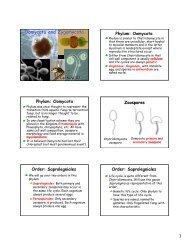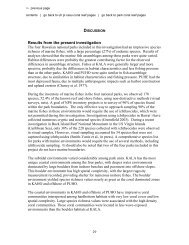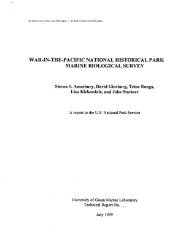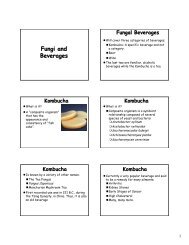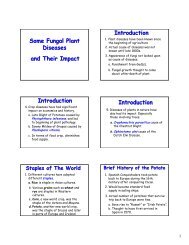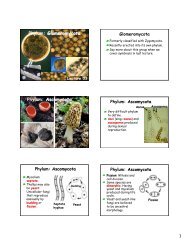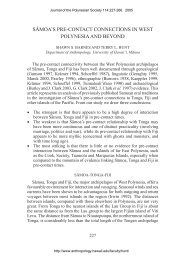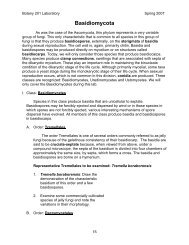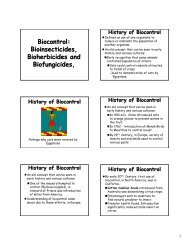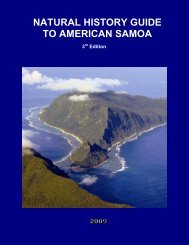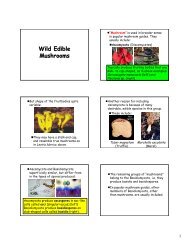american samoa - University of Hawaii at Manoa Botany Department
american samoa - University of Hawaii at Manoa Botany Department
american samoa - University of Hawaii at Manoa Botany Department
- No tags were found...
Create successful ePaper yourself
Turn your PDF publications into a flip-book with our unique Google optimized e-Paper software.
East Portion <strong>of</strong> the MarshThe impact <strong>of</strong> the taro leaf blight led some families, who had title to communal lands in theMarsh, to begin production <strong>of</strong> Chinese cabbage in the east portion <strong>of</strong> the marsh. This crop isnow sold <strong>at</strong> the Fag<strong>at</strong>ogo marketplace (Puaauli, 1999). Once the new blight-resistant cultivars<strong>of</strong> taro become more readily available, taro production may once again be established within, <strong>at</strong>least, the east portion <strong>of</strong> the Marsh.West Portion <strong>of</strong> the MarshIn 1992, Biosystems Analysis, Inc. observed taro cultiv<strong>at</strong>ion along with willow primrose in theTaufusi marsh. It was also noted th<strong>at</strong> soils in Taufusi Marsh “....drain slowly enough tosupport wetland plants”. With the more recent discontinu<strong>at</strong>ion <strong>of</strong> taro production, the westportion <strong>of</strong> the wetland transitioned to a disturbed marsh.It is likely th<strong>at</strong> the west portion <strong>of</strong> the marsh will continue to be domin<strong>at</strong>ed by commelina.However, if the smaller hibiscus p<strong>at</strong>ches <strong>at</strong> the west end <strong>of</strong> the marsh continue to spread, thefau (Hibiscus tiliaceus) could possibly shade out the marsh veget<strong>at</strong>ion and cre<strong>at</strong>e a fresh-w<strong>at</strong>ermarsh domin<strong>at</strong>ed by fau (beach hibiscus).AQUATIC FISH AND INVERTEBRATESGeneralOn November 2, 1999, Charles Chong <strong>of</strong> the PPC field survey team made observ<strong>at</strong>ions <strong>of</strong>aqu<strong>at</strong>ic fish and invertebr<strong>at</strong>es along a segment <strong>of</strong> Mulivaitele Stream from the east side <strong>of</strong>Taufusi Marsh to approxim<strong>at</strong>ely 380 feet upstream <strong>of</strong> the Mulivaitele Stream mouth. Hisobserv<strong>at</strong>ions are summarized in the following paragraphs.The stream did not exhibit a stream discharge into the nearshore w<strong>at</strong>ers during the field survey.However, a nominal flow <strong>of</strong> less than 0.5 cubic feet per second (cfs) flowed downstream to apoint th<strong>at</strong> was about 380 feet upstream <strong>of</strong> the shoreline. At this point, stream flows percol<strong>at</strong>edinto the bottom <strong>of</strong> the stream channel.Mulivaitele Stream Segment Along East Side <strong>of</strong> MarshThe fish and invertebr<strong>at</strong>e survey focused upon the segment <strong>of</strong> the Mulivaitele Stream channelbetween the east side <strong>of</strong> Taufusi Marsh to approxim<strong>at</strong>ely 380 feet upstream <strong>of</strong> the streammouth. The bed <strong>of</strong> the stream channel was characterized by cobble on top <strong>of</strong> clay soil. Therewas moder<strong>at</strong>ely heavy canopy above the stream. However, there was little or no periphytonalong this stream segment.The stream fauna contained an abundance <strong>of</strong> the fresh-w<strong>at</strong>er shrimp Macrobrachium lar th<strong>at</strong> isknown to be amphidromous. Kuhlia rupestris was also abundant in larger pools. No gobies oranguillids were observed, although they have may have been present further upstream.Non-amphidromous species included the same chironoid larvae found in the Alao wetland.Many types <strong>of</strong> damselflies and dragonflies were also documented.American Samoa Wetland/Stream Restor<strong>at</strong>ion and Enhancement PlanFebruary 2001, Alao Wetland, Page 3-7



